
Filling the Gap
April 22, 2010
By Bill Tice
From the roof of one of North America’s lar-gest biomass power plants, Wayne Clarke, the facility’s manager, surveys the huge mounds of wood fibre that fill the yard below.
From the roof of one of North America’s lar-gest biomass power plants, Wayne Clarke, the facility’s manager, surveys the huge mounds of wood fibre that fill the yard below. These mountains of cellulose are wood waste from sawmills and roadside residuals from logging operations. Just a few years back, these byproducts from the forest industry would have been incinerated in beehive burners or burned as slash in the bush once logging operations had been completed. They were the products nobody wanted and, in some cases, sawmills even paid to have them carted away.
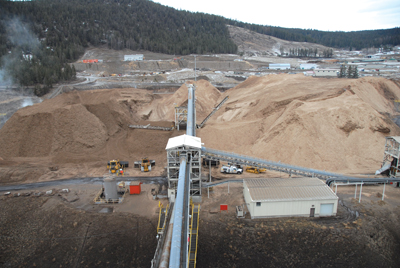 |
| Mountains of wood fibre can be seen from the roof of the Capital Power LP Williams Lake biomass power plant in Williams Lake, British Columbia.
|
How things have changed in today’s world, where biomass has become a rapidly growing commodity. The Williams Lake, British Columbia, facility, which is owned by Edmonton, Alberta-based Capital Power Income LP, typically consumes in excess of 600,000 tonnes of green wood waste during an average year, says Clarke. From his vantage point on the plant’s roof, he points out the numerous sawmills just beyond the power plant’s fences. These wood products producers used to supply most of the fuel needed to run the plant. But as he lists off the mills that are currently shut down or on limited production schedules due to tough times in the wood products business, he adds that the British Columbia forest industry’s economic woes have created a scenario that has become one of the biggest challenges facing a plant such as this one.
“Two thirds of our fuel mix still comes from our traditional sources, that being the area sawmills, but the other third is now derived from roadside logging waste, and a very small amount from nonstandard sources such as clean and untreated urban wood waste,” Clarke explains. “The slowdown in the wood products business has made it more expensive and difficult to bring wood waste in from the bush than to source it from nearby sawmills.”
Added Cost
That extra cost comes in the form of transportation, additional processing measures, and variability in the wood, especially when it comes to moisture content, which Clarke says can be much higher in the logging waste, especially in winter. “Overall, the wood coming from the sawmills is just much more consistent and it is a very uniform product.”
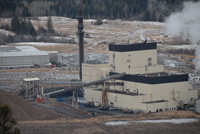
|
| The biomass power plant operates on a steady diet of sawmill and forest residuals.
|
When using more logging waste in the mix, Clarke says that they also face chal-lenges with stable delivery schedules because they have to factor in things such as spring break-up and other weather conditions that can impede the logging contractors’ ability to deliver. “We have to make sure we have enough fibre in inventory to cover our needs during these times,” he adds.
For Clarke, the magic number in terms of inventory is 35 to 45 days of fibre supply in the yard. “We are fortunate in that we have some very proactive logging contractors here in the Williams Lake area that have made sure our fibre supply has stayed intact,” he says. “Although fibre from logging waste is a lower quality than what we get from the sawmills, many of our contractors have come to the forefront and have been able to deliver what we need.”
Clarke joined Capital Power just over a year ago. However, he is no stranger to the business and has extensive experience in working with boilers, energy production, and wood fibre. Prior to taking on his new role, the professional engineer was with lumber giant West Fraser Timber Co. Ltd. at its Cariboo Pulp mill, which is located about 125 km north of Williams Lake in Quesnel, British Columbia.
The Power Plant
Inland Pacific Energy Corporation and Tondu Energy Systems Inc. built the Williams Lake power plant 17 years ago at a cost of approximately $150 million. The rated capacity for the plant was originally 60 MW and is currently 66 MW. The plant, which employs about 28 people, runs on a continuous basis. BC Hydro, which is the main energy supplier to industrial and residential customers in British Columbia, is the plant’s largest customer, consuming most of the power produced.
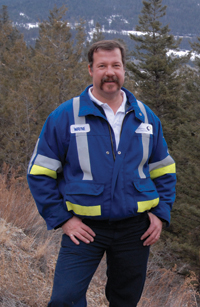 |
| Wayne Clarke is manager of the 66-MW Williams Lake power plant.
|
In addition to supplying energy, the plant was built as a way to alleviate smoke and ash issues created by area sawmill beehive burners. It was in the late 1980s when the provincial government, the local utility, the sawmill owners, and the public got together to look at ways to improve the region’s air quality, which some residents say was so bad that their home smoke detectors would be triggered on a regular basis and their cars would frequently be covered in ash. Construction on the plant got underway in 1991, with commercial operations starting in April 1993.
“It was the perfect window of opportunity to build a power plant in this area,” Clarke says. “The infrastructure and fuel were here, the need was here, the desire was here, and it was, and still is, economically viable.”
Through amalgamations and mergers, the plant has changed hands several times since it was built. Capital Power Income has operated it since July 2009.
Production Matters
Watching the loaded trucks line up for the mill’s two chip dumpers, it’s clear that despite the slowdown in the forest industry, the power plant is getting the volume of wood fibre it needs right now to operate comfortably. All of the wood fibre is brought in by truck, regardless of whether it is sourced at a local mill, from the woods, or from the landfill. A 65-foot and an 85-foot chip dumper, both manufactured by Megatech Engineering of Surrey, British Columbia, unload regular chip trailers. Trailers with moving floors are emptied into an unloading bin that is equipped with conveyors.
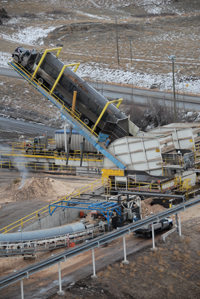 |
| Two chip dumpers and an unloading bin handle all of the wood fibre that is delivered to the Williams Lake power plant.
|
Once in the wood infeed system, the fibre is processed through metal detectors and a Grizzly hogger from Brunette Industries in New Westminster, British Columbia, a process that provides what Clarke calls “a homogeneous mix” of fairly equal amounts of bark, sawdust, and shavings that is debris free and the ideal size for the plant’s requirements. Once processed, the mix is moved to the main storage benches in the yard, where it is aged. When ready for the plant, the fibre is moved by a pair of Caterpillar D9 dozers and a Komatsu D275 dozer to the “reclaim pile” and a pair of Industrial Service Inc. reclaimers. A conveyor system that is equipped with another screen then transports the fibre to the plant.
The wood fibre is gravity-fed into the boiler, which is a Stirling CCZ (controlled combustion zone furnace) two-drum model with a water-cooled vibrating grate stoker. Designed by Babcock & Wilcox Canada, the boiler is rated at 950°F and 1590 PSI. Clarke notes that when the fuel is in the boiler, it has a three-second retention time in the furnace. Any heavy material drops to the vibrating grate system and out to an ash bunker for delivery to the ash landfill.
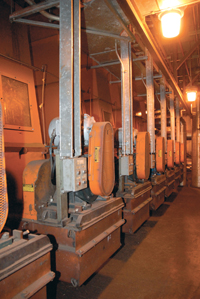
|
| The bark feeder bins and screw drives at the plant transfer fibre from the distribution conveyor to the furnace at a controlled rate.
|
Going in the other direction, hot gases that are produced by the boiler go to the economizer, where water going though tubes is turned into “superheated” steam. The steam is then delivered to a General Electric steam turbine, which in turn drives the plant’s General Electric generator, where the electricity is produced before being delivered to the grid. The hot gases are directed through a series of cyclone-type separators to remove dust before being processed through an Environmental Elements Corporation five-field electrostatic precipitator. The clean vapour is then released into the atmosphere through a 200 foot tall stack.
The plant also features sophisticated hybrid Bailey and Delta V digital control systems that provide an integrated means of monitoring, archiving, and logging instrument signals. The digital control systems also alert staff through an alarm system if there are problems with the plant’s equipment, and interface with the turbine and generator controls for load control and shutdown functions.
Looking Forward
Down the road, Clarke believes the company will continue to look at innovative options – like the current use of roadside residuals – to overcome fuel supply issues and sawmill curtailments. He says that the internal use of biomass for internal power production by a wave of new energy systems being installed in sawmills and other wood processing facilities will take a toll on supply.
This, in turn, will likely mean that reliance on logging waste is here to stay. “Looking into the future is a little like looking into a crystal ball,” he admits. “As sawmill production numbers likely won’t return to their previous volumes for some time, the ‘future normal’ appears to be smaller than what it was in the past. Between lower production volumes and sawmills using biomass for their own needs, I expect that logging debris will continue to play a role for this plant.” •
Print this page